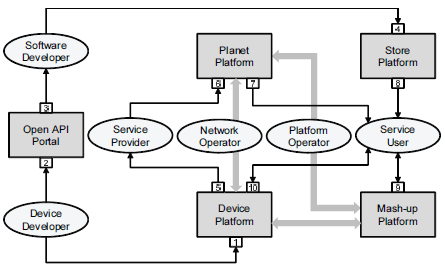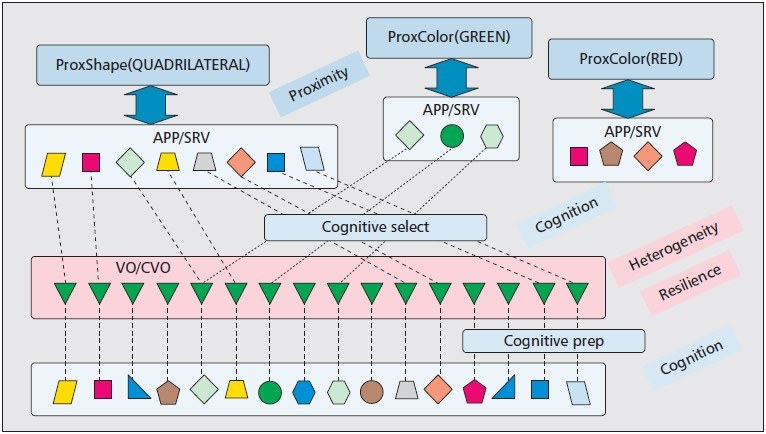How can IoT Frameworks make a difference?
The term IoT refers to the world of “things” that interact over a network. The term “things” refers to living organisms or dummy objects that can be equipped with sensors, processing power and network connectivity. For example, smart phones are objects that can sense information from the world and transfer it to other objects. A smart phone can be used to read an RFID tag embedded in a board or a piece of clothes and gets information about it [1].
Researchers in IoT are interested more in availing information on the Internet with minimal human interaction. This approach provides more accurate information and reduces human mistakes in normal data-entry. New architecture IoT architecture models can benefit from the advancement of the IoT which avails on-demand-data [1]. Software engineers can then use this on-demand information to build real-time services.
The commercial benefits that can be generated from the IoT services are enormous. According to Kim and Lee [2] there are 6 main players who can benefit from ecosystems based on IoT services. According to Kim and Lee (Figure F‑16) the device developer provides the suitable device to host an application which is generated by a software developer. The service provider purchases the application and asks the Platform Operator to host it. The Service User then uses the application using the Network Operator.

Figure F‑16 Ecosystem of IoT services [2]
Kim and Lee developed an Open Source platform called OpenIoT (Figure F‑17) in order to recognize the mentioned ecosystem. The framework consists of four major platforms (Planet Platform, Mash-up Platform, Store Platform and a Device Platform) to facilitate, for the ecosystem stakeholder, the interaction through open-source APIs.

Figure F‑17 Open Service framework for IoT services [2]
Vlacheas et al. [3] proposed a framework for self-management and self-configuration. They claim that their framework addresses three major challenges related to the large number of objects and the associated complexity and unreliability that comes with them due to their inherited heterogeneity. They introduced a Virtual Object (VO) that models a Real World Object (RWO). They also introduced a Composite Virtual Object (CVO) which is considered a cluster of objects that provides services.

Figure F‑18 a technical view of the cognitive management framework for the Internet of Things [3]
They divide their framework into VO, CVO, and service level. Cognition is adopted along these three levels. The Virtual Object (VO) needs to keep a link with the RWO via self-management and self-configuration to help the VO learn and generate knowledge about the RWO. For the CVO level, self-management and self-configuration are used to let the CVO provide the application requirements. Finally, the cognition technique in the service level aims to capture the application requirements and policies in order to help the CVO in its selection process for VOs (Figure F‑18).
On the other hand, real world objects represent a different challenge for other researchers. Perera et al. [4] worked on designing a framework to discover sensors and configure them. They consider their model important as they address some major challenges in the sensor discovery and configuration process. These challenges are:
- The number of sensors: this requires autonomous configuration if the number of sensors grows.
- Heterogeneity of Sensors: Different sensors use different technologies with different communication protocols, and different types of data.
- Sampling rate, scheduling, and communication frequency: the strategies of defining the frequency at which sensors collect data, for defining the time table for sensing and communication, and the setting of the frequency of data transmission through the network.
- Data acquisition: sensors may push data to clouds, or clouds pull data from sensors. Which technique to use?
- Dynamicity: it has to do with the appearance, position, and movement of sensors
- Context: Sensors can be configured in a better way if the context is well understood
Accordingly, the authors propose a Context-aware Dynamic Discovery of Things (CADDOT) Framework model which has specific tasks to detect, extract, identify, find, retrieve, register, reason, and configure sensors using a generic approach that tries different communication protocols (Figure F‑19).

Figure F‑19 CADDOT Model for Sensor Configuration [4]
Li et al. [5] discuss a futuristic architecture platform (MobilityFirst) that enables access to things by their Global Unique Identifier (GUID). The architecture as shown in Figure F‑20 consists of three major services:
- Global Name Resolution Service (GNRS): which holds a proper mapping between the GUID and the network address
- Hybrid GUID/network address routing: which takes routing decisions for data blocks based on the GUID/network address mapping
- Delay-tolerant network (DTS) transport: which provides a caching and forwarding mechanism based on routing decisions
Services attached to objects or sensors can be built on top of this service stack without worrying about object mobility.

Figure F‑20 MobilityFirst Core Network Architecture [5]
References
[1] J. Gubbi, R. Buyya, S. Marusic, and M. Palaniswami, “Internet of Things (IoT): A vision, architectural elements, and future directions,” Future Gener. Comput. Syst., vol. 29, no. 7, pp. 1645–1660, 2013.
[2] J. Kim and J. W. Lee, “OpenIoT: An open service framework for the Internet of Things,” in 2014 IEEE World Forum on Internet of Things (WF-IoT), 2014, pp. 89–93.
[3] P. Vlacheas et al., “Enabling smart cities through a cognitive management framework for the internet of things,” IEEE Commun. Mag., vol. 51, no. 6, pp. 102–111, Jun. 2013.
[4] C. Perera, P. P. Jayaraman, A. Zaslavsky, D. Georgakopoulos, and P. Christen, “Sensor discovery and configuration framework for the Internet of Things paradigm,” in 2014 IEEE World Forum on Internet of Things (WF-IoT), 2014, pp. 94–99.
[5] J. Li, Y. Shvartzshnaider, J. A. Francisco, R. P. Martin, and D. Raychaudhuri, “Enabling Internet-of-Things services in the MobilityFirst Future Internet Architecture,” in 2012 IEEE International Symposium on a World of Wireless, Mobile and Multimedia Networks (WoWMoM), 2012, pp. 1–6.
